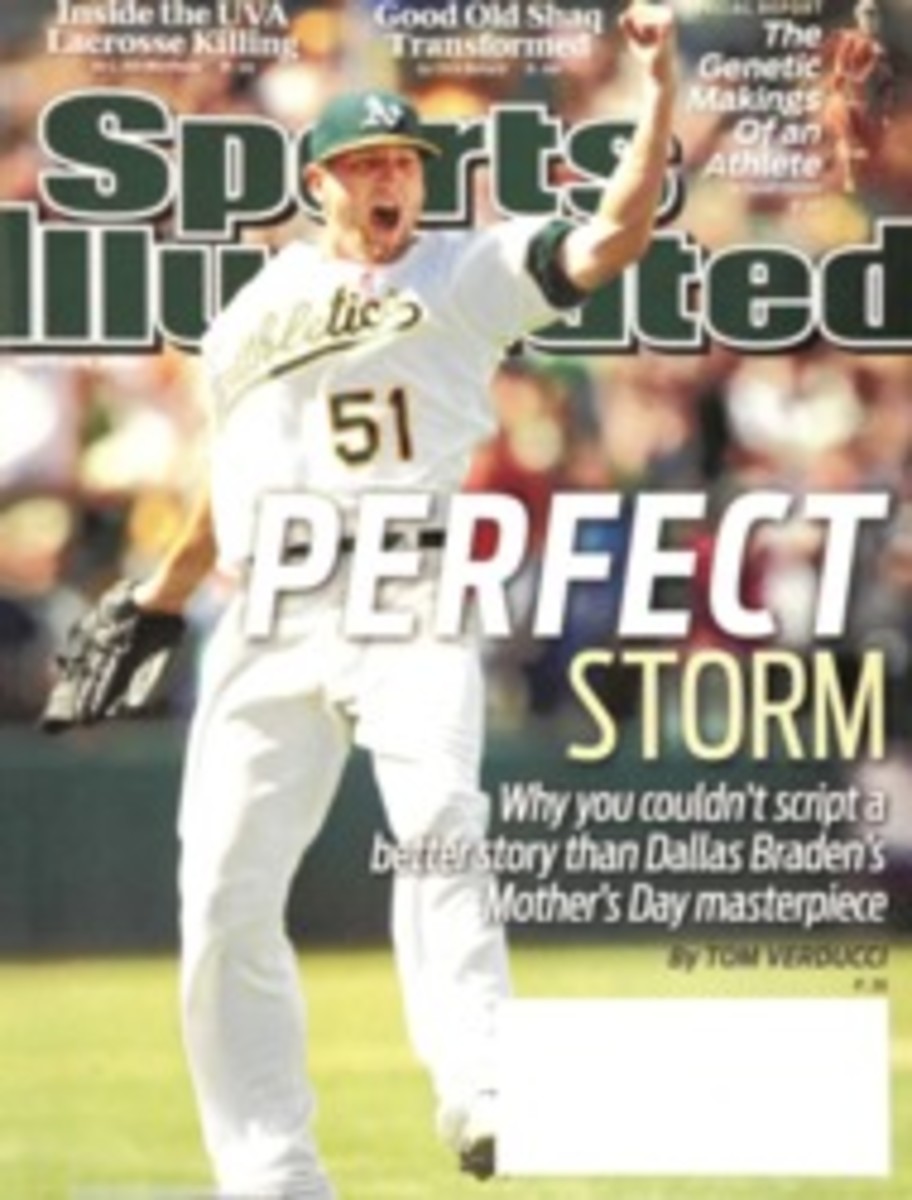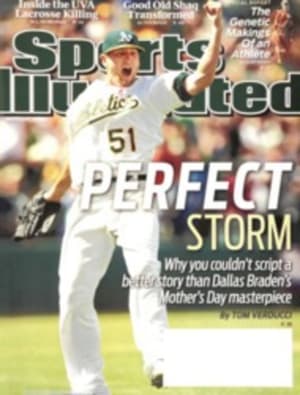
On the Clock
It's the catchphrase for slow play and the last thing a player wants to hear from a rules official. Here's a primer on one of the longtime headaches on the PGA Tour
In PGA Tour circles, it's called the Prize. The Prize, the Tour's version of the Scarlet Letter, is what a player gets for being timed for slow play on 10 occasions in a season. A player—along with everyone he's playing with—gets timed when his group falls behind either the pace of play (a.k.a. Time Par) or the group ahead of them. Getting timed is called being on the clock, and a player who takes too long to play a shot while he is on the clock is in danger of being fined and possibly penalized, although the latter is rare.
The Prize is actually a $20,000 fine and was first levied against Brent Geiberger in 2004. Tour rules officials decline to provide other details, but the Prize is believed to have been handed out to more than 10 but fewer than 20 other players since '04. The guilty include more than one major champion, and last year a player allegedly earned the Prize by the Memorial Tournament, in early June. After a player is given the Prize, each additional timing in a calendar year draws an additional $5,000 fine.
The Prize is based on the assumption that the threat of a fine increases peer pressure on slow players because pros paired with a known snail run the risk of becoming a Prize winner by association. Players who have had multiple timings tend to become speedier—and testier—when they're paired with a known slow-baller. "I don't care who you are, nobody wants to write a check for 20 grand," says Mark Russell, the Tour's vice president of rules and competitions.
Slow play is a longtime problem as well as an inevitable source of frustration on the PGA Tour. "Nobody ever does anything about it," gripes rapid-playing Rory Sabbatini, who brought up the topic, again, at a recent players meeting. Says Brian Claar, a rules official and former Tour player, "The fast guys all say we don't do anything, and the slow guys all say we pick on them."
The reality is that slow play is almost unavoidable on Tour. Half of a tournament field of 144 players (some have fields up to 156) tees off on the 1st and 10th tees in the morning; the other half does likewise in the afternoon. "With 156 players on a course—that's 26 threesomes on 18 holes in each wave—you don't need a degree from MIT to know those numbers don't work," says Russell. "We try to keep a flow going. If a player never had to wait to play a shot, he'd never say a word about pace of play. It's the stand-around-and-wait part that's the problem."
Pace-of-play rally-killers include requests for rulings, lost balls, taking drops and bad play, among other variables. Rules officials felt a little like Maytag repairmen last week during the Players Championship. Until Sunday there was only light wind, and scores were low. When Spencer Levin tapped in a 17-inch putt to conclude first-round play at 7:30 p.m., it meant that the entire field was off the course in under five hours. O.K., it was close—four hours, 59 minutes—and on Friday the pace was 10 minutes slower, but breaking the five-hour barrier is an uncommon feat at the demanding TPC Sawgrass Stadium course.
On Saturday, with only 70 players making the cut and the field playing in twosomes, play went ridiculously smoothly and the final twosome finished in 4:10. Only five groups were timed for being out of position through three rounds, compared with an estimated 30 timings at last year's Players. Being a golf cop is a thankless job, but last week wasn't so bad. "We're like airline pilots—hours of boredom followed by moments of terror," Russell says.
Here's your PGA Tour Slow Far, Slow Good Handbook: Everything You Need to Know About Slow Play but Took Too Long to Ask. (And let's pick it up, people, you're taking forever to read this.)
Clockblocked
Forget Greenwich Mean Time. On the PGA Tour, Time Par (no relation to Old Man Par) is what matters. Time Par is the time it should take to play each hole, as determined by the rules crew after careful study. At the Players, for instance, Time Par was two hours, 14 minutes for the front nine and 2:15 for the back, plus five minutes to make the turn. Time Par for the entire round by a threesome was 4:34, 3:58 for a twosome.
The 40 Time
How cool would it be if golf, like basketball, had a shot clock? It would be handy too, because once a group has been alerted that it's on the clock, a player has 40 seconds to hit his shot once it's his turn. The first to play the tee shot on a par-3, a second shot on a par-4 or par-5, a third shot on a par-5 or a stroke near or on the green, gets an additional 20 seconds. If a player exceeds his allotted time, he receives a bad timing.
Penalty Box
A player's first bad timing is a freebie. He gets a mulligan. The second offense in the same round results in a one-shot penalty. The third offense is two penalty strokes, and the fourth is disqualification. But multiple offenses simply don't happen. "The system is beatable, and everybody knows how to beat it," says Tour veteran Fred Funk. "If a guy gets fined or penalized, he has a serious problem."
Timing a group is usually effective for as long as it lasts. "If I told you there's a traffic cop running a speed trap and you went through it and got a ticket, to go through it again and get another ticket would be pretty dumb," says rules official Jon Brendle. "Once I tell you you're on the clock, you're not going to go over the time." Once the group is off the clock, the offending player is free to resume his tortoiselike ways.
There is a lifetime-achievement-type aspect to bad timings, however. The second time a player gets a bad timing in the same calendar year results in a $5,000 fine. Each subsequent bad timing earns a $10,000 hit. Major championships, World Golf Championships and Nationwide tour events are included. The last Tour player who unintentionally drew a one-shot penalty for slow play (a few players have purposely done so in protest over rulings) was Dillard Pruitt at the 1992 Byron Nelson Classic. Pruitt is now a Tour rules official.
Speedier Play Secret No. 1
Walk faster. Is that too obvious? Apparently not. Carl Pettersson was first off in the final round of the recent Quail Hollow Championship as a single. He played in 2:15 because he walked briskly. "Jack Nicklaus got a hard time because he could be slow over the ball," Brendle says, "but he always walked fast so he could afford to be slow over the ball. It's a pretty simple fix for slow play—walk faster, get there sooner."
Speedier Play Secret No. 2
The lost art of the tap-in annoys Claar. "You don't see anybody knock it up there and tap it in," he says. "These guys all have to line up their putt with the line they drew on the ball. If everybody marks and waits, it's another minute and a half per hole. It adds up."
Speedier Play Secret No. 3
When it's your turn to play, go ahead and play. "I tell guys, 'You don't hit balls on the range like this, and you hit 'em pretty good,' " says Russell. "You don't wait two minutes to hit every seven-iron shot."
The Race for the Cure
Richard Johnson is no longer among the Tour's slowpokes. "We had a tight TV window at Reno and had to start at daybreak," Russell says. "The lead guy was Richard Johnson, the slowest player you could imagine. I went on the 1st tee and said, 'Richard, you're leading off,' and he said, 'Mark, you don't have to say another word. I have an 11 o'clock flight and have to be on it.' He shot 64 that day and finished in the top 10. I saw him a few weeks later and asked what he learned. 'Unbelievable,' is all he said, and we've never had another problem with him."
Slowtime
One nominee for the latest Slowest Player on Tour, a label held by Ben Crane ever since Sabbatini finished a hole at Congressional in 2005 while Crane fiddled with his shot from the fairway, is Kevin Na, a fidgety player who can't seem to pull the trigger. He was paired with Ángel Cabrera, one of the game's fastest golfers, at last year's Players. "I watched Kevin play a shot from under the trees, just a layup shot, and it took him five full minutes," Brendle says. "Ángel was 200 yards ahead, waiting, so I drove up there. He looked at me and said, 'Gringo. Me play with Kevin Na. Painful.' I broke up, I couldn't help it."
The Slo-Mo Magnificent Seven
Rules officials refused to name names on who's holding up play, so I took an unofficial survey of players, caddies and media. The winners are Na, definitely; Fredrik Jacobson ("Killer slow," one poll subject says); Masters champs Trevor Immelman and Zach Johnson ("Major slow"); J.B. Holmes ("He likes to visualize the shot first—apparently in super slo-mo"); Michael Letzig ("He's lucky he plays in the back of the pack or he'd be getting timed every round"); and Sean O'Hair. Honorable mention: Crane ("Most improved"), Padraig Harrington, Stewart Cink, D.A. Points, Sergio García, Omar Uresti ("The O-Man is Slow-Man"), Jeff Overton and Bob Estes.
Alltime Slow-baller
Nick Faldo ("Bernhard Langer got a bad rap. Nick was way worse").
Notable Nonexempt Snails
Colt Knost and Casey Wittenberg, now back on the Nationwide after a year as the PGA Tour's slowest new faces. Knost had decision-making issues, especially reading putts, while Wittenberg has a laborious preshot routine, including one ninjalike pose with his club straight up in the air as he painstakingly takes his grip.
Hall of Blame
The sports psychologists who tell golfers to visualize the shot and never hit until they're ready. "They started all this," Claar says.
Best Place to Hide If You're Slow
Late-in-the-day tee times, where play usually bogs down anyway.
Worst Place to Hide If You're Slow
One of the first three groups off the tee. Time Par was effectively invented for them because they're pacesetters for the field and, as such, are closely monitored (and prodded when necessary) by their friendly neighborhood golf cops.
GOLF.COM · SIGOLFNATION.COM
Now on GOLF.com
Follow all the action at TPC San Antonio and this week's Valero Texas Open at GOLF.com
Psychologists who tell pros to visualize shots "started all this," says Claar.
FIFTEEN PHOTOS
Photographs by ROBERT BECK
MINUTE MAN Crane took 60 seconds—20 more than allowed in one instance—to hit this shot at the 12th hole during the first round of the Players.
PHOTO
JACQUELINE DUVOISIN (FALDO)
BEATING THE SYSTEM Faldo was the slowest of them all, while Brendle (below) says players revert to slow play when taken off the clock.
PHOTO
FRED VUICH
[See caption above]

